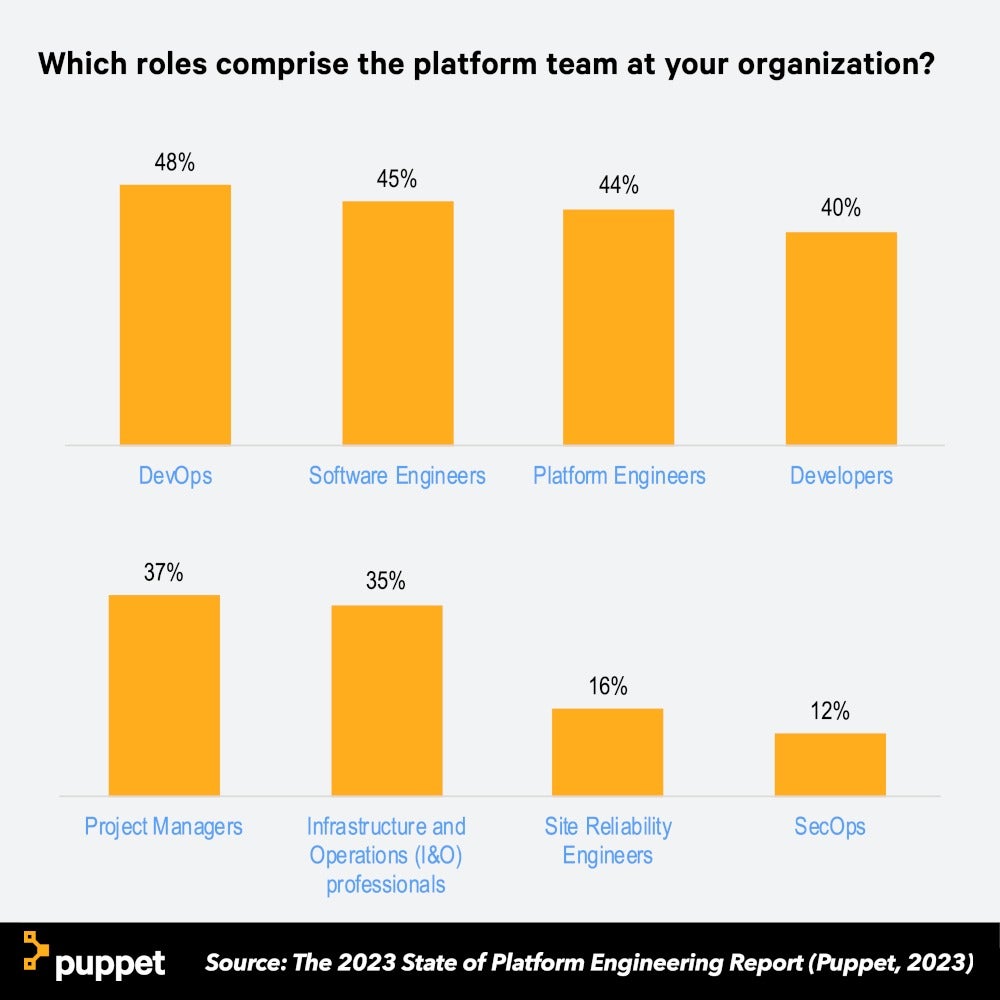Blog
July 17, 2023
Platform Engineering Tools: 12 Types of Tools to Use in Your Platform
Platform Engineering,
DevOps
Platform engineering tools are the apps and services in an internal developer platform (IDP), like configuration management, provisioning, testing, automation, CI/CD, and more. Your actual IDP should comprise tools your team actually needs: Your choice of platform engineering tools matters because it defines what your dev team can do on their own.
But that doesn’t mean you’re completely on your own for finding and choosing platform engineering tools – particularly if you’re just starting out. Take a look below for information on the types of tools you’ll often find in a developer platform and how they work together to build an effective, efficient platform.
Table of Contents
- What Are Platform Engineering Tools?
- How Do You Use Platform Engineering Tools?
- Platform Engineering Tools to Try
- Examples of Platform Engineering Tools + Where They Fit in an IDP
- How to Pick the Right Platform Engineering Tools
- Learn More About Platform Engineering + Tools Platform Engineers Use
What Are Platform Engineering Tools?
Platform engineering tools are the set of apps and services in an internal developer platform (IDP). Common types of platform engineering tools include configuration management, automation, deployment, containerization, testing, CI/CD, IaC, orchestration, and more.
Because every DevOps team is different, every internal developer platform will be different. The common thread is that every IDP enables DevOps self-service, which helps developers work faster, more efficiently, and with fewer bottlenecks.
How Do You Use Platform Engineering Tools?
Developers use platform engineering tools to code, build, test, and release software independently. Platform engineers build internal developer platforms (IDPs) with platform engineering tools.
The purpose of platform engineering is to enable developer self-service. That means letting devs do things like spinning up new resources, merging and testing code, and deploying all from one platform – and without the cognitive load of having to seek out direction from other teams or departments.
Keys to Platform Engineering SuccessOur free report features 40+ pages of survey stats, definitions, and tips from teams that actually use platform engineering. |  |
Platform Engineering Tools to Try
It can’t be said enough that every IDP is different. Your choice of tools should be based on what your team does most often, what they’d like to be able to do, and where your developers would find most value in self-service. That said, most developer platforms have a few tools in common.
Dive into all of our great platform engineering resources in our content hub >>
Here are a few common platform engineering tools to use:
- Ticketing tools
- Provisioning tools
- Configuration management tools
- Version control software
- Infrastructure-as-code tools
- Containerization tools
- Orchestration tools
- DevOps automation tools
- Application performance monitoring tools
- CI/CD tools
- Automated testing tools
- Reporting tools
12 Examples of Platform Engineering Tools + Where They Fit in an IDP
Platform Engineering Tool | Where it Fits in an IDP | Examples |
Ticketing | Tickets are used for approvals and tracking. | |
Provisioning | Using provisioning tools in an IDP lets developers spin up new resources and development environments. | Puppet, Terraform |
Configuration Management | Use configuration management tools in your IDP to manage configuration files and establish consistency and repeatability across environments. | Puppet |
Version Control Software | Version control software lets developers collaborate to monitor and manage changes to their codebase. That’s invaluable when many devs are working from the same platform. | Perforce Helix Core, Git |
Infrastructure as Code (IaC) | IaC tools let your dev team write infrastructure setup and configuration as code, which means they can reproduce infrastructure automatically on their own, right from your IDP. | Puppet |
Containerization | Containerization packages applications in isolated, portable, scalable environments to let your dev team work faster with less risk. | Kubernetes, Docker |
Orchestration | Orchestration lets you automate and manage the deployment and scaling of applications (whether containerized or non-containerized). | Kubernetes, OpenShift, Nomad, Puppet (for on-prem and cloud infrastructure) |
DevOps Automation | Automation in DevOps streamlines the common tasks associated with the development and operations cycle. | Puppet |
Application Performance Monitoring | Observability tools like application performance monitoring tools let you see and understand app performance in real time. | BlazeMeter, Perfecto |
Continuous Integration/Continuous Deployment (CI/CD) | CI/CD tools automate code commits and deployment from your developer platform. | |
Automated Testing | Automated testing tools can help ensure software quality from your IDP with less effort on the part of developers. | |
Reporting | Companies can use reporting tools to make better business decisions based on the utilization and effectiveness of the tools in their IDP. | Splunk, PowerBI |
How to Pick the Right Platform Engineering Tools
Like we said above, there’s no perfect set of platform engineering tools. Your platform will probably look different from another company’s platform. Generally, though, it’s smart to choose tools with two primary factors in mind:
- Extensibility: An IDP should respond to the needs of developers. That often means adding new tools to the platform when needed. Make sure you’re picking tools that let you integrate new tools and services.
- Scalability: An IDP needs to be able to serve the team you have today, but it should also be able to scale with your DevOps team. If you’re a DevOps organization, consider that your devs may not be the only ones using the platform.
Most importantly, if you’re choosing platform engineering tools for an IDP, you should first find out what its users would find useful. Getting a variety of perspectives is vital to building a useful platform. Our 2023 State of DevOps Report: Platform Engineering Edition found that platform teams at most organizations are made up of a variety of roles, including DevOps (48%), software engineers (45%), developers (40%), SREs (16%), and more.

Go out and actually ask your team where their pain points are. Conduct user research, build an IDP roadmap, get feedback, evangelize the IDP, and understand its meaningful outcomes. Create a conversation and common understanding around your platform and you’ll quickly learn what tools are actually helpful.
Sounds more like product engineering than a process, right? That’s because platform engineering can only work if the people building the platform treat it like a product. A good IDP is planned with the user in mind, deployed in a way that makes the user’s work easier, and iterated upon over time.
Learn More About Platform Engineering + Tools Platform Engineers Use
Platform engineering is on the rise because it helps organizations get more from their DevOps. The 2023 State of DevOps Report: Platform Engineering Edition from Puppet zooms in on the trend for organizations considering platform engineering. With 40+ pages of data from surveys conducted with companies already doing platform engineering, the State of Platform Engineering Report is the definitive resource for unpacking the hype.
Learn more by downloading the free report from Puppet.
